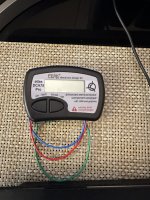I thought that was your plan from the start.
I'd suggest cornell dubilier to narrow down the choices. Others can offer their opinions on them.
The 'capacitor plague' was a problem caused by bad electrolyte. More information can be found on wikipedia.
I'd suggest cornell dubilier to narrow down the choices. Others can offer their opinions on them.
The 'capacitor plague' was a problem caused by bad electrolyte. More information can be found on wikipedia.
any recommendation as far as temp range? the snap in caps are 85c ..but would it be ok to use a higher temp, say 105c, and a longer life say 5000 hrs vs 1000hrs...what are the benefits or disadvantages?
85C is perfectly fine.
The hours are for testing the cap when it's stressed to the limits. Your caps will never be stressed anything near that. If you want to buy caps with longer life or 105c won't do any harm. That said, generally, 105c caps are often larger so it may be difficult to find the same capacitance that is the same size.
One more note. The 105c caps are typically only needed where the caps have a hard life and on the primary side. The inductor on the B+ input makes the life of the caps very easy.
For amps that are hard on caps (some of the old Rockfords were REALLY tough on caps. Those required the lowest ESR available, 105C caps.
Your Alpine was so conservatively built that virtually everything in it has an easy life.
The hours are for testing the cap when it's stressed to the limits. Your caps will never be stressed anything near that. If you want to buy caps with longer life or 105c won't do any harm. That said, generally, 105c caps are often larger so it may be difficult to find the same capacitance that is the same size.
One more note. The 105c caps are typically only needed where the caps have a hard life and on the primary side. The inductor on the B+ input makes the life of the caps very easy.
For amps that are hard on caps (some of the old Rockfords were REALLY tough on caps. Those required the lowest ESR available, 105C caps.
Your Alpine was so conservatively built that virtually everything in it has an easy life.
well, I should have left well enough alone. after recapping the boards I have no bias in one of the channels. I haven't a clue where to start. any suggestions? again would be appreciated.
Hi Perry, I don't know if the channel produces audio. I do have a 4 channel lab cope. The bias was dead even on both channels before the capacitor change. I have my pos and neg rail voltages which lead me to believe the problem is a wire or connection to the driver board. The three-legged
transistors that I unsoldered to remove the main PC board had other existing wires soldered to the legs. I think possibly a bad connection when I resoldered the transistor legs to the board.
transistors that I unsoldered to remove the main PC board had other existing wires soldered to the legs. I think possibly a bad connection when I resoldered the transistor legs to the board.
If you have a scope, follow the signal from the back of the RCA jacks toward the power amplifier section to see where the signal is lost.
Ok, were good now. bias responds well on both channels via the pot adjusters. I found a brown wire going to one of the pnp transistor that had come loose. How do i know the correct orientation of the dvom probes. if i invert the probes on the test points the voltage is either pos or neg. does it matter?
Hi Perry, well after getting music on both channels for about 3 minutes there was a stream of smoke coming from the amplifier. the amplifier no longer powers up. what would cause the power supply to shut down like that? What is the most common power supply component that usally goes bad?
Would it be a good idea to disconnect the driver board and start looking for faults on power supply board?
Were the transistors clamped to the heatsink when the parts smoked?
Have you gone through the amp and checked for shorted transistors (those on the heatsink)?
Is it possible that you installed a capacitor with reverse polarity?
Have you gone through the amp and checked for shorted transistors (those on the heatsink)?
Is it possible that you installed a capacitor with reverse polarity?
ok, I will take the amplifier apart again and check for a cap installed in the wrong orientation. I do have 2 of these amplifiers. I also have a transistor tester so it should be pretty easy.
ok, with the driver board disconnected i get plus and minus 30 volts.. on the rails...i also checked the pnp/npn transistors that mount to the board. i believe those are the output transistors. those also test fine.
- Home
- General Interest
- Car Audio
- Alpine 3502 not turning on?
